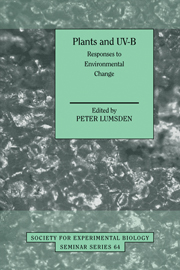Book contents
- Frontmatter
- Contents
- List of contributors
- Preface
- PART I The ozone layer and UV-B radiation
- PART II Effects of UV-B on plants at the cellular level
- PART III Effects of UV-B at the whole plant and community level
- Effects of solar UV-B radiation on aquatic ecosystems
- Assessing the impact of UV-B radiation on the growth and yield of field crops
- Effects of UV-B radiation on plants from agro- and natural ecosystems
- Effects on subarctic vegetation of enhanced UV-B radiation
- Impacts of elevated UV-B on forest ecosystems
- Effects of elevated UV-B radiation and elevated CO2 on heathland communities
- Alterations in competitive balance
- Interations between trophic levels
- Index
Effects on subarctic vegetation of enhanced UV-B radiation
Published online by Cambridge University Press: 04 August 2010
- Frontmatter
- Contents
- List of contributors
- Preface
- PART I The ozone layer and UV-B radiation
- PART II Effects of UV-B on plants at the cellular level
- PART III Effects of UV-B at the whole plant and community level
- Effects of solar UV-B radiation on aquatic ecosystems
- Assessing the impact of UV-B radiation on the growth and yield of field crops
- Effects of UV-B radiation on plants from agro- and natural ecosystems
- Effects on subarctic vegetation of enhanced UV-B radiation
- Impacts of elevated UV-B on forest ecosystems
- Effects of elevated UV-B radiation and elevated CO2 on heathland communities
- Alterations in competitive balance
- Interations between trophic levels
- Index
Summary
Introduction
On-going depletion of the stratospheric ozone layer may lead to changes in the radiation climate that could seriously affect the biosphere. Therefore, many research groups around the world have conducted experiments to find out how organisms, in particular marine phytoplankton (see chapter by Häder, this volume) and terrestrial plants (see other chapters by Rozema et al, Corlett et al., Moody et al. and Caldwell), react to increased levels of UV-B radiation. Most experiments on terrestrial plants have been conducted with crop plants, and just a few with forest trees. Before our field experiments in Northern Scandinavia were started in 1991, no experiment had been conducted in which a natural ecosystem with plants, animals and microorganisms was exposed to increased UV-B.
UV radiation effects on growth, biomass production and survival of plants can be broadly subdivided into two classes, direct effects and indirect effects. Direct effects include radiation-induced changes in individual plants that affect their photosynthesis, cell division, or other life processes of direct importance to growth and development. Indirect effects include those that are mediated by radiation-induced changes in the plant environment, or changes in the plant which are of importance mainly for the plant's relation to other organisms. Much more effort has so far been expended trying to understand the direct effects, and they may be the most important ones in crops, growing as they do in a partly human-controlled environment, and mostly in monoculture.
- Type
- Chapter
- Information
- Plants and UV-BResponses to Environmental Change, pp. 233 - 246Publisher: Cambridge University PressPrint publication year: 1997
Accessibility information
- 13
- Cited by

